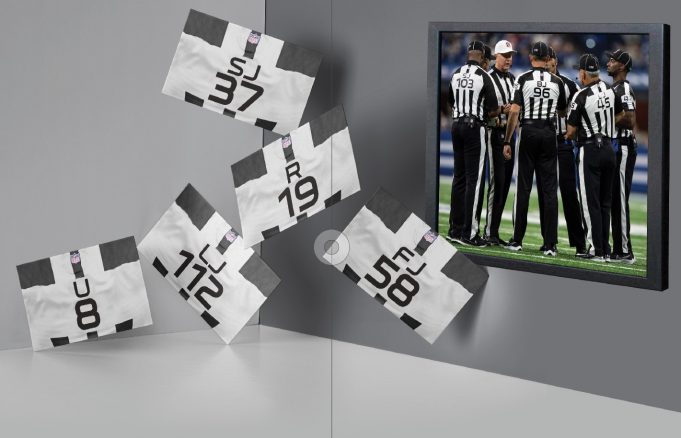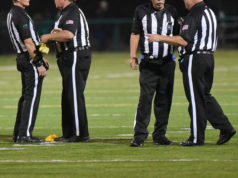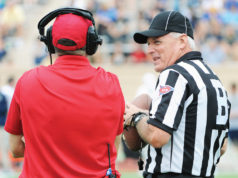What’s in a number? You’d be surprised how some NFL officials wound up with their uniform numbers, and the history behind those identifying digits.
On the back and left shoulder of every NFL game official is a key identifier — a uniform number. When officials join the league, assigning them a number is a very early order of business.
The number — worn by NFL officials since 1942 — gives the official an identity beyond the black-and-white-striped shirt. Ask any NFL official and there will likely be a story on how he or she obtained the number or some other personal connection to the digits. It also serves as another way to know which official ruled on a particular play when assignment details are not readily available or recalled by memory.
“You know who’s assigned to the game, but it does save a step,” said Dean Blandino, NFL vice president of officiating from 2013-17. “If someone sent me a play, while I knew who was assigned to the game, it was immediate in identifying the official.”
Numbers worn in the NFL have included 1 all the way to 142, with some exceptions.
In the first Super Bowl — then known as the NFL-AFL Championship Game — three officials represented each league. Each of the officials’ numbers ended with 0 and the backups’ numbers ended with 1. Thus, referee Norm Schachter was number 10, umpire George Young was number 20, head linesman Bernie Ullman wore number 30, line judge Al Sabato sported number 40, field judge Mike Lisetski was assigned number 50 and back judge Jack Reader was number 60.
But it wasn’t always that simple.
Beginning with the 1979 season, the NFL flirted with an eventual failed experiment — duplicate numbers assigned by position. That season, the NFL assigned numbers by position, predominantly from 3 through 20, excluding 13. So, with seven game officials across multiple positions, but not on the same regular-season crew, could there ever be a problem?
In back-to-back Super Bowls, number 7 caused a problem for the NFL. Fred Silva and Al Conway both wore number 7 during the regular season and were assigned to Super Bowl XIV. Fortunately, Silva wore a black hat as the referee and Conway wore a white hat as the umpire, but they wore identical numbers during the game.
Head linesman Tony Veteri Sr., line judge Tom Dooley, back judge Tom Kelleher and field judge Fritz Graf all wore number 7 during the 1980 season and were assigned to Super Bowl XV. Instead of doubling down on the previous year’s debacle, Kelleher was the only number 7 during the game, based on his seniority. Veteri, Dooley and Graf were given different numbers for the game. Veteri wore 8, Dooley wore 10 and Graf wore 17.
The experiment ultimately would be short-lived and most officials went back to unique numbers for the 1982 season.
“WE’LL SAVE A SPOT FOR YOU”
Retired down judge Ed Camp wore number 134 and did so proudly despite stereotypes of it being a bottom-of-the-barrel, triple-digit number.
“I was crushed,” Camp said when he learned of his number assignment when he joined the league. “But it’s grown on me.”
Camp did not hold the highest number, however, as Pete Morelli sported number 135. Only field judge Dave Warden and back judge Perry Paganelli have worn higher numbers in the history of the league. Warden wore number 137 during the 1998 season before switching to number 27 for his final four seasons, while Paganelli wore number 142 in 1998 and switched to number 46 after that season.
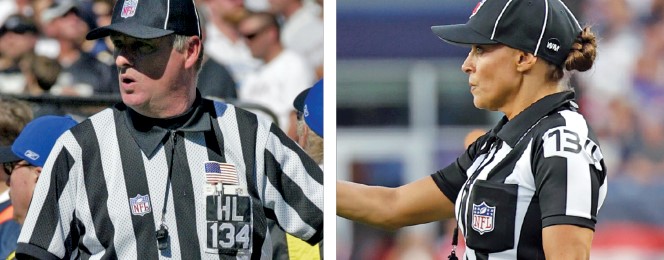
As if to molify him, Camp was told 134 is only 100 digits away from longtime referee Gerald Austin (34), who was assigned to three Super Bowls.
“We’ll save a spot for you,” Camp said he was told by college officiating peers when he told them his NFL number assignment. “You’ll be back.”
Camp, in the league since 2000, was assigned as the down judge for Super Bowl LIII — never returning to his former NCAA stomping grounds.
Now, after Camp’s retirement at the end of the 2021 season — culminating with his third assignment as a Super Bowl alternate — Robin DeLorenzo wears number 134 after being hired into the NFL for the 2022 season.
DeLorenzo referenced Camp as her first mentor in the New Jersey Football Officials Association North (NJFOA) in a Facebook post when Camp was slated to work the 2022 AFC Championship game as the down judge — presumably his last assignment before being selected as a Super Bowl alternate two weeks later. DeLorenzo met Camp on the first night of her cadet class in an effort to become a high school football official in New Jersey.
“Throughout my college career, there are always three calls that go out when I get a promotion or a special game: my parents, Tom (DeLorenzo’s husband) and Ed Camp,” DeLorenzo said in the post.
“Between the cadet classes every week where (Camp) would show us hours of film, to the study sessions, to coming to our games, to showing up to clinics to share his experiences. The man dedicated his whole life to football and making sure the NJFOA North (and other groups) had the most prepared officials around!” she wrote.
THE OFFICIAL BEFORE ME
When Jerome Boger joined the NFL in 2004, he was fortunate enough to choose his number — initially picking number 109 from a batch of unassigned numbers. But another number caught his eye — 23.
That’s because it previously belonged to Johnny Grier, the NFL’s first Black referee. Boger and Grier developed a bond and Boger shared a wish with Grier.
“JG, when you retire, I want you to tell me so I can tell the office I’d like your number,” Boger said he told Grier in 2004.
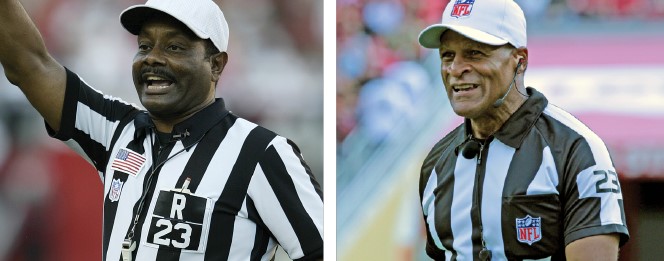
Two years later, that wish came true when Boger wore number 23 beginning with the 2006 season. “He’s always been special to me,” Boger said of Grier.
“When there is a request, we would certainly honor a request where we could,” Blandino said of his tenure. That was not the case under all NFL officiating leaders, however, as others merely assigned numbers.
Blandino said the process is a bit “random.”
Boger said he continues to enjoy his number as a tribute to Grier but said the number carries added meaning when talking with players.
He said he’ll seek out players on the field wearing the same number as his during the pregame and share a moment, usually saying, “I’ve worn this number for 15 years. Hopefully, you can do the same.”
That conversation, Boger said, is another avenue to have a human conversation with players before everything gets crazy.
Boger’s son, Tra, was hired into the NFL for the 2022 season and wears number 2. Jerome and Tra become the first father-son duo to work in the NFL at the same time since Steve and Brad Freeman were onfield officials through the 2019 season. Steve Freeman opted out of the 2020 season and subsequently retired.
OFF LIMITS
While no numbers have officially been retired by the NFL, some administrators have given certain numbers a “cooling-off period” after a retirement or transition.
When Al Riveron joined the league office after the 2012 season, Blandino said the league would not assign his former number 57 unless Riveron felt there was an official deserving. Since Riveron’s departure from the field, number 57 had not been worn until the 2020 season, when it was assigned to field judge Joe Blubaugh.
That has not always been the case as referees like Jerry Markbreit and Jim Tunney, working a combined seven Super Bowls, did not see their numbers — 9 and 32 respectively — put on hold.
For the longest time, numbers 1 and 13 were kept on the shelf. Under Blandino, then-incoming field judge and now referee Scott Novak was assigned number 1 and incoming down judge Patrick Turner was assigned number 13.
“My birthday is 13,” Blandino said of his birthdate. “It hasn’t been unlucky for me.”
Sixty-nine, however, remains off limits allegedly due to its sexual connotations.
ALL IN THE FAMILY
A number of family members have been selected to officiate in the NFL — some concurrently and others years apart. Some family members have had the opportunity to honor their family history in the NFL by wearing a number “in the family.”
Walt Coleman spent his entire career as number 65. When Walt IV joined the league in 2015, he wore number 87. But following Walt’s retirement after the 2018 season, Walt IV was able to change to number 65, which continued a family tradition dating back to 1989 — the longest such streak in NFL history.
The Baynes family has a similar legacy, but not continuous. Former side judge and line judge Ron Baynes wore number 56 throughout his career. When Baynes’ career came to a close after the 2000 season, number 56 sat vacant until 2008. That’s when Allen Baynes, Ron’s son, joined the NFL and number 56 became a perfect fit.
But when Rusty Baynes, Ron’s other son joined the league in 2010 as a line judge, he was out of luck, since Allen already captured the “family number.” Rusty secured a nearby number, 59.
Jim Quirk Sr. spent more than 20 years in the NFL as a line judge and umpire wearing number 5. But in the 2009 season, with Quirk no longer in the league, John McGrath switched from number 120 to 5.
That led to an interesting conversation when Jim Quirk Jr. was hired into the league. Initially, Quirk Jr. wore number 63, but toward the end of McGrath’s career. McGrath said to Quirk Jr., “When I retire, you should take this number back.”
And that’s exactly what happened. Quirk Jr. has worn number 5 since the beginning of the 2017 season, when McGrath left the field.

